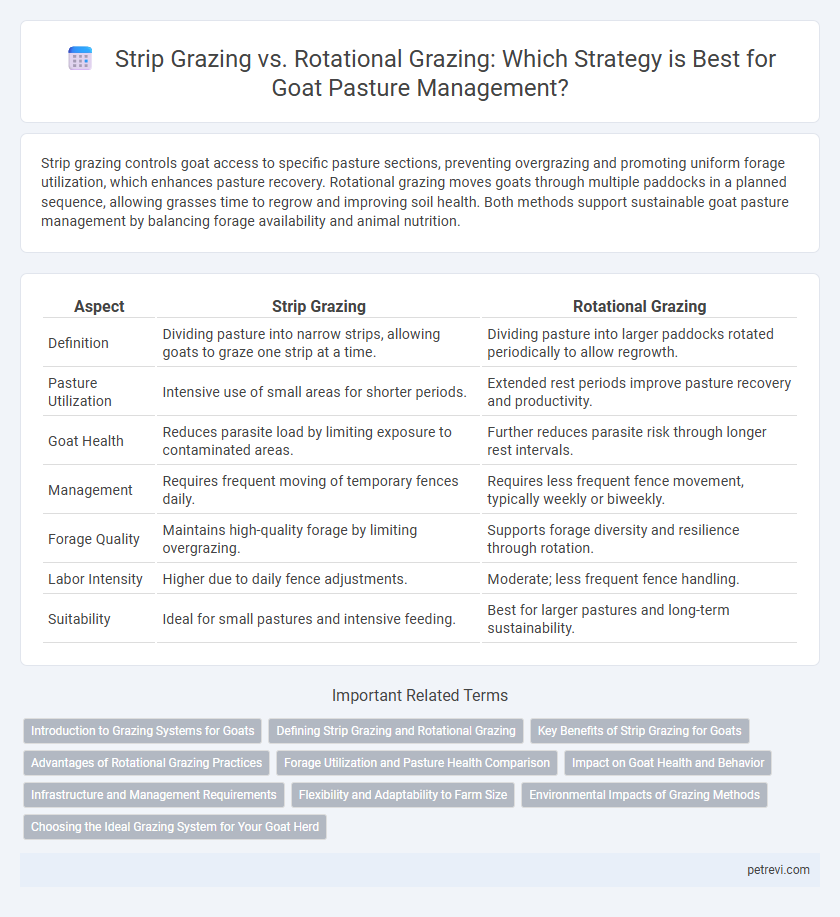Strip grazing controls goat access to specific pasture sections, preventing overgrazing and promoting uniform forage utilization, which enhances pasture recovery. Rotational grazing moves goats through multiple paddocks in a planned sequence, allowing grasses time to regrow and improving soil health. Both methods support sustainable goat pasture management by balancing forage availability and animal nutrition.
Table of Comparison
| Aspect | Strip Grazing | Rotational Grazing |
|---|---|---|
| Definition | Dividing pasture into narrow strips, allowing goats to graze one strip at a time. | Dividing pasture into larger paddocks rotated periodically to allow regrowth. |
| Pasture Utilization | Intensive use of small areas for shorter periods. | Extended rest periods improve pasture recovery and productivity. |
| Goat Health | Reduces parasite load by limiting exposure to contaminated areas. | Further reduces parasite risk through longer rest intervals. |
| Management | Requires frequent moving of temporary fences daily. | Requires less frequent fence movement, typically weekly or biweekly. |
| Forage Quality | Maintains high-quality forage by limiting overgrazing. | Supports forage diversity and resilience through rotation. |
| Labor Intensity | Higher due to daily fence adjustments. | Moderate; less frequent fence handling. |
| Suitability | Ideal for small pastures and intensive feeding. | Best for larger pastures and long-term sustainability. |
Introduction to Grazing Systems for Goats
Strip grazing confines goats to small, manageable pasture sections, promoting targeted forage utilization and reducing overgrazing. Rotational grazing involves moving goats between larger pasture areas on a scheduled basis, allowing forage plants time to recover and maintain pasture health. Both systems improve nutrient cycling and parasite control, but strip grazing typically offers more precise grazing control and pasture rest periods tailored to goat needs.
Defining Strip Grazing and Rotational Grazing
Strip grazing involves dividing pasture into narrow strips and allowing goats to graze one strip at a time, promoting uniform forage utilization and minimizing overgrazing. Rotational grazing consists of moving goats through multiple pasture sections or paddocks on a scheduled basis, enabling forage recovery and improving pasture sustainability. Both methods optimize forage management by controlling grazing intensity and duration.
Key Benefits of Strip Grazing for Goats
Strip grazing enhances forage quality by concentrating grazing pressure on narrow pasture sections, leading to more uniform plant regrowth and reduced overgrazing. This method optimizes nutrient intake for goats, promoting better weight gain and overall health by allowing frequent access to fresh, high-quality forage. Improved pasture utilization and soil health are achieved through controlled grazing periods and rest, resulting in sustainable pasture management and increased forage productivity.
Advantages of Rotational Grazing Practices
Rotational grazing enhances pasture productivity by allowing specific sections to recover and regrow, improving forage quality and availability for goats. This practice reduces soil erosion and promotes nutrient cycling, leading to healthier pasture ecosystems and increased animal performance. Implementing rotational grazing also decreases parasite build-up, minimizing health risks and reducing the need for chemical treatments.
Forage Utilization and Pasture Health Comparison
Strip grazing maximizes forage utilization by confining goats to narrow pasture strips, promoting more uniform grazing and reducing selective feeding, which leads to improved pasture regrowth and soil health. Rotational grazing involves moving goats between multiple paddocks, allowing for longer rest periods that enhance forage recovery, increase biodiversity, and prevent overgrazing. Studies indicate rotational grazing generally supports better pasture health and sustainable forage production, while strip grazing offers efficient short-term forage utilization but may require careful management to avoid pasture degradation.
Impact on Goat Health and Behavior
Strip grazing limits goats to small, controlled pasture sections, promoting selective feeding and reducing parasite intake, which supports better health and prevents overgrazing. Rotational grazing cycles goats through multiple paddocks, enhancing pasture regrowth and diversifying forage intake, which encourages natural foraging behaviors and improves nutrient balance. Both methods influence goat stress levels and social interactions, with rotational grazing generally fostering more natural herd dynamics and reducing the risk of nutritional deficiencies.
Infrastructure and Management Requirements
Strip grazing requires temporary fencing systems and movable water sources, demanding frequent adjustments and labor to control goat movement efficiently. Rotational grazing relies on permanent fences subdividing pastures into paddocks, facilitating scheduled grazing periods and rest cycles to promote pasture recovery and reduce parasite loads. Both methods necessitate well-planned infrastructure, but rotational grazing involves higher initial investment with long-term pasture and herd health benefits.
Flexibility and Adaptability to Farm Size
Strip grazing offers precise control over forage consumption and is highly adaptable to small-scale farms by restricting goats to narrow pasture strips, preventing overgrazing and allowing rapid forage regrowth. Rotational grazing provides flexibility for larger farms by systematically moving goats through multiple paddocks, optimizing pasture recovery and improving soil health across diverse terrain sizes. Both methods can be tailored to specific farm dimensions and goat herd sizes, enhancing pasture sustainability and productivity.
Environmental Impacts of Grazing Methods
Strip grazing minimizes soil erosion and nutrient runoff by controlling grazing intensity and allowing vegetation recovery, which enhances pasture sustainability. Rotational grazing promotes biodiversity by providing diverse grazing habitats and prevents overgrazing through planned pasture rest periods. Both methods reduce environmental degradation compared to continuous grazing, but rotational grazing typically offers greater ecosystem resilience and improved water quality.
Choosing the Ideal Grazing System for Your Goat Herd
Strip grazing maximizes forage utilization by confining goats to narrow pasture strips, reducing overgrazing and promoting regrowth, which supports sustainable pasture health. Rotational grazing divides pasture into multiple paddocks, allowing rest periods that enhance forage recovery and soil fertility while controlling parasite buildup. Selecting the ideal system depends on herd size, pasture availability, and management intensity, with strip grazing fitting smaller herds and high forage demand, while rotational grazing suits larger herds and long-term pasture sustainability.
Strip Grazing vs Rotational Grazing for Goat Pasture Management Infographic

 petrevi.com
petrevi.com